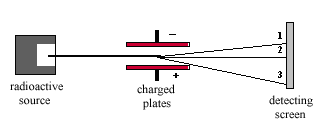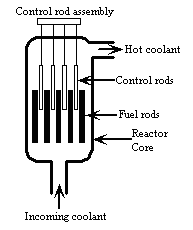 |
1 |  | 
The tremendous amount of energy released by nuclear reactions is primarily due to |
|  | A) | mass balance. |
|  | B) | mass defect. |
|  | C) | meltdown. |
|  | D) | control rods. |
 |
 |
2 |  | 
"Natural" sources of radiation that humans may be exposed to include |
|  | A) | radon. |
|  | B) | cosmic rays. |
|  | C) | dental x-rays. |
|  | D) | radon and cosmic rays. |
 |
 |
3 |  | 
Consider this reaction:
23892U ----> 23490Th + X
What is the nature of the entity "X"? |
|  | A) | gamma ray |
|  | B) | beta particle |
|  | C) | alpha particle |
|  | D) | helium ion |
 |
 |
4 |  | 
Which statement about fission is correct? |
|  | A) | Fission involves a chain reaction. |
|  | B) | Fission involves pairs of elemental products (of less mass than the element that decays) and several neutrons. |
|  | C) | The fission process can be manipulated in a reactor via the use of control rods that absorb neutrons. |
|  | D) | All of these statements are correct. |
 |
 |
5 |  | 
How are spent fuel rods disposed of at most nuclear power plants? |
|  | A) | The rods are transported by truck to the High-Level Waste federal repository at Yucca Mountain, Nevada. |
|  | B) | The rods are stored on-site in steel-lined water-filled concrete containers or placed in dry cask storage. |
|  | C) | The rods are sent to a reprocessing facility, which then returns new fuel pellets to the power station. |
|  | D) | The rods are transported by train to the salt mine storage facility in southeastern New Mexico. |
 |
 |
6 |  | 
Which statement about the Pu-239 found in spent fuel rods is correct? |
|  | A) | Pu-239, formed from U-238 in fuel rods, has the potential to be diverted for weapons. |
|  | B) | Pu-239 can be separated from fuel rods, but it is not fissionable so there is no market for it. |
|  | C) | Pu-239 is routinely being recovered and reprocessed and used to produce nuclear power. |
|  | D) | Pu-239 is present in very low concentrations in fuel rods, and therefore has little potential for either peaceful uses or weapons production. |
 |
 |
7 |  | 
What is the half-life of the radioisotope X shown in this graph?
 <a onClick="window.open('/olcweb/cgi/pluginpop.cgi?it=gif::::/sites/dl/free/0072410159/51621/7A7.gif','popWin', 'width=NaN,height=NaN,resizable,scrollbars');" href="#"><img valign="absmiddle" height="16" width="16" border="0" src="/olcweb/styles/shared/linkicons/image.gif"> (1.0K)</a> <a onClick="window.open('/olcweb/cgi/pluginpop.cgi?it=gif::::/sites/dl/free/0072410159/51621/7A7.gif','popWin', 'width=NaN,height=NaN,resizable,scrollbars');" href="#"><img valign="absmiddle" height="16" width="16" border="0" src="/olcweb/styles/shared/linkicons/image.gif"> (1.0K)</a>
|
|  | A) | 1 s |
|  | B) | 2 s |
|  | C) | 3 s |
|  | D) | 4 s |
 |
 |
8 |  | 
How many neutrons are represented by this symbol?
 <a onClick="window.open('/olcweb/cgi/pluginpop.cgi?it=gif::::/sites/dl/free/0072410159/51621/7A8.gif','popWin', 'width=NaN,height=NaN,resizable,scrollbars');" href="#"><img valign="absmiddle" height="16" width="16" border="0" src="/olcweb/styles/shared/linkicons/image.gif"> (0.0K)</a> <a onClick="window.open('/olcweb/cgi/pluginpop.cgi?it=gif::::/sites/dl/free/0072410159/51621/7A8.gif','popWin', 'width=NaN,height=NaN,resizable,scrollbars');" href="#"><img valign="absmiddle" height="16" width="16" border="0" src="/olcweb/styles/shared/linkicons/image.gif"> (0.0K)</a>
|
|  | A) | 50 |
|  | B) | 63 |
|  | C) | 113 |
|  | D) | 163 |
 |
 |
9 |  | 
This experimental set up shows a naturally radioactive source emitting an alpha particle and a beta particle, together with a gamma ray. Which number identifies which type of emission?
 <a onClick="window.open('/olcweb/cgi/pluginpop.cgi?it=gif::::/sites/dl/free/0072410159/51621/7A9.gif','popWin', 'width=NaN,height=NaN,resizable,scrollbars');" href="#"><img valign="absmiddle" height="16" width="16" border="0" src="/olcweb/styles/shared/linkicons/image.gif"> (2.0K)</a> <a onClick="window.open('/olcweb/cgi/pluginpop.cgi?it=gif::::/sites/dl/free/0072410159/51621/7A9.gif','popWin', 'width=NaN,height=NaN,resizable,scrollbars');" href="#"><img valign="absmiddle" height="16" width="16" border="0" src="/olcweb/styles/shared/linkicons/image.gif"> (2.0K)</a>
|
|  | A) | 1 = gamma, 2 = beta, 3 = alpha |
|  | B) | 1 = beta, 2 = gamma, 3 = alpha |
|  | C) | 1 = beta, 2 = alpha, 3 = gamma |
|  | D) | 1 = alpha, 2 = gamma, 3 = beta |
 |
 |
10 |  | 
Which of these transmutations is most likely to sustain a chain reaction in a nuclear power station?
Reaction 1:23994Pu + 42He ----> 24296Cm + 10n
Reaction 2:23592U + 10n ----> 9037Rb + 14455Cs + 2 10n
Reaction 3:23994Pu + 2 10n ----> 24195Am + 0-1e
Reaction 4:23892U ----> 23490Th + 42He |
|  | A) | 1 |
|  | B) | 2 |
|  | C) | 3 |
|  | D) | 4 |
 |
 |
11 |  | 
Gamma rays are part of the electromagnetic spectrum. Gamma rays, compared to the ultraviolet region of the spectrum, have |
|  | A) | lower energy, higher frequency, and longer wavelengths. |
|  | B) | lower energy, lower frequency, and shorter wavelengths. |
|  | C) | higher energy, higher frequency, and shorter wavelengths. |
|  | D) | higher energy, lower frequency, and shorter wavelengths. |
 |
 |
12 |  | 
Which of these subatomic particles has the smallest mass? |
|  | A) | electron |
|  | B) | neutron |
|  | C) | proton |
|  | D) | nucleus |
 |
 |
13 |  | 
Which of these are possible factors to explain support for nuclear power in the United States?
I. excellent record of safety
II. concerns about global warming
III. rising price of natural gas
IV. concerns about long-term storage of waste |
|  | A) | I and III only |
|  | B) | II and IV only |
|  | C) | I, II, and III only |
|  | D) | I, II, III, and IV |
 |
 |
14 |  | 
This diagram shows the reactor core in a typical nuclear power plant. What are the control rods made of, and how do they work to control the nuclear reaction?
 <a onClick="window.open('/olcweb/cgi/pluginpop.cgi?it=gif::::/sites/dl/free/0072410159/51621/7B9.gif','popWin', 'width=NaN,height=NaN,resizable,scrollbars');" href="#"><img valign="absmiddle" height="16" width="16" border="0" src="/olcweb/styles/shared/linkicons/image.gif"> (2.0K)</a> <a onClick="window.open('/olcweb/cgi/pluginpop.cgi?it=gif::::/sites/dl/free/0072410159/51621/7B9.gif','popWin', 'width=NaN,height=NaN,resizable,scrollbars');" href="#"><img valign="absmiddle" height="16" width="16" border="0" src="/olcweb/styles/shared/linkicons/image.gif"> (2.0K)</a>
|
|  | A) | The control rods are made of neutron-producing materials such as boron, and they can be automatically dropped into the core to initiate the nuclear reaction. |
|  | B) | The control rods are made of high quality stainless steel, and they are raised or lowered to extract the heat generated by the energy of fission. |
|  | C) | The control rods are made of uranium pellets, and they can be inserted individually to achieve the mass needed for the fission reaction. |
|  | D) | The control rods are made of neutron-absorbing materials such as cadmium, and they can be raised or lowered to regulate the power level of the reactor. |
 |
 |
15 |  | 
In the relationship E = mc2, the letter "c" represents |
|  | A) | the speed of the particles emitted in a nuclear reaction. |
|  | B) | the Celsius temperature of the nuclear reaction. |
|  | C) | the speed of light. |
|  | D) | the difference between the masses of the reactants and those of the products. |
 |
 |
16 |  | 
Carbon-14 (14C) dating is used to predict the age of certain items derived from living organisms. The half-life of 14C is about 6,000 years. For a 4 mg sample of 14C, how many years will be required to pass before the sample contains only 1 mg of 14C? |
|  | A) | 12,000 years |
|  | B) | 6,000 years |
|  | C) | 3,000 years |
|  | D) | 2,500 years |
 |

